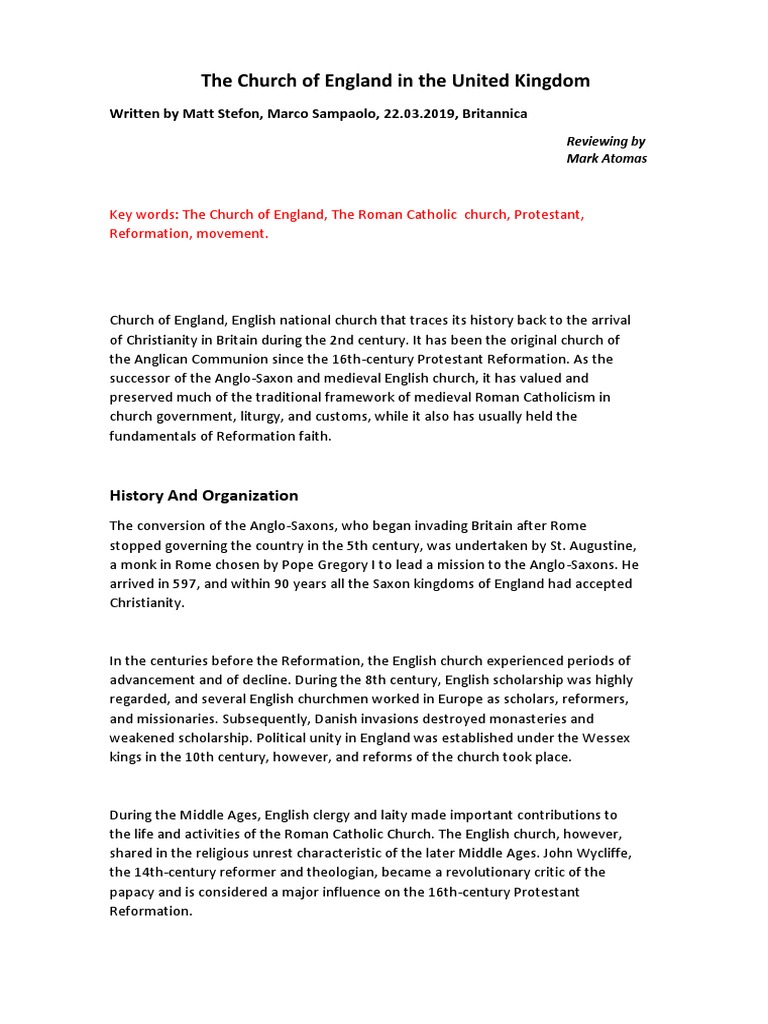The Church of England, quintessentially intertwined with the very fabric of English history, finds its origins deeply rooted in a confluence of religious fervor and political intrigue. To understand when the Church of England commenced its existence as a distinct entity, one must position it within the broader contexts of the Reformation and the complex relationship between England and the Roman Papacy.
History often reveals unexpected pivots. The emergence of the Church of England cannot be divorced from the volatile reign of King Henry VIII during the early sixteenth century. At the heart of this schism lay not merely theological disputes but rather the personal tribulations of a monarch. The quintessential moment often pinpointed as the genesis of the Church of England was 1534, when the Act of Supremacy declared Henry VIII as the Supreme Head of the Church of England.
Yet, to appreciate the significance of this event, it is paramount to trace the historical circumstances that precipitated such a momentous decision. For a myriad of reasons, including familial legitimacy and the fervent quest for a male heir, Henry’s pursuit led him to confront the papal authority, particularly Pope Clement VII, who found himself mired in political machinations and alliances that complicated Henry’s marriage to Catherine of Aragon.
The failure to annul Henry’s marriage stemmed from numerous factors, most notably the Pope’s allegiance to Catherine’s nephew, the Holy Roman Emperor Charles V. Henry’s frustrations snowballed, transforming personal grievances into a revolutionary act of ecclesiastical defiance. Thus, while most inquiries into the Church of England’s initiation might focus on this 1534 legislation, the ripples of its inception stretch far earlier, entwined with national identity, power dynamics, and the collective psyche of the English populace.
As the monarch’s fervor for sovereignty escalated, so did the theological undercurrents that characterized the burgeoning English Reformation. The Church of England emerged not simply as a replication of Roman practice, but as an institution shaped by distinct English contours. The English Reformation, heralded by figures like Thomas Cranmer, sought not only to sever ties with Rome but to instigate significant changes within the Church itself.
Emphasis on the vernacular Bible—the translation of sacred texts into English—fostered a deeper engagement with the faith. The Church of England began to advocate for scriptural accessibility, which resonated with a populace yearning for religious autonomy. This pivotal shift promoted a more personal relationship with God, challenging clerical intermediaries and redefining communal worship.
Furthermore, the socio-political tapestry of early modern England crafted an environment ripe for change. The dissolution of monasteries, orchestrated between 1536 and 1541, catalyzed an extensive reallocation of wealth and property, engendering both a spiritual and societal upheaval. Monastic lands were appropriated for the crown, and the traditional structures of faith and community encountered disruption. This transformative moment underscored the fusion of governance and religion, marking institutional shifts that would echo through the ages.
As the burgeoning Church of England delineated its identity, it also faced opposition. The emergence of various sects—including the Puritans—highlighted the tensions within Protestantism itself. These factions sought to purify the Church, pressing for further reforms that would eventually precipitate a series of tumultuous events, including the English Civil War. In turn, these religious factions redefined notions of piety, challenging the status quo established during Henry’s reign.
In parallel, the theological implications of this new ecclesiastical framework began to materialize distinct doctrines that separated the Church of England from its Roman counterpart. The Thirty-Nine Articles, formulated in 1563, sought to articulate these tenets, attempting to establish a middle way—an agreeable theological stance between Roman Catholicism and radical Protestantism. This embodiment of Anglicanism underscored the church’s commitment to both tradition and reform, allowing for a diversity of beliefs that has continued to define its character.
The highs and lows of the Church of England’s history have inevitably shaped its contemporary identity. From the glories of Elizabethan England, which presented a cultural renaissance alongside religious establishment, to the arduous trials of dissent and schism, the Church has proven resilient yet malleable. The legacy of its origins persists, an enduring dialogue between faith and reason, tradition and change.
To reflect on when the Church of England truly began is to engage in a conversation about continuity and rupture—the delicate interplay of historical moments and personal choices. The act of breaking from Rome was not solely about repudiation; it was as much about embracing a vision of a church that was singularly English, ruled not by foreign authority, but by its own sovereign spirit. It heralded a reformation that transformed not just the church but the entire nation, seeding the socio-religious complexities that still characterize Anglicanism today.
Ultimately, the narrative of the Church of England serves as a prism through which one can explore broader themes of identity, authority, and faith in a changing world. Its inception is not merely a historical footnote but a vivid canvas reflecting the tensions and aspirations of a people navigating the tumultuous waters of religious reform. The Church of England invites us to ponder the intricate dance of faith and freedom, a legacy that continues to unfold in modernity’s embrace.



